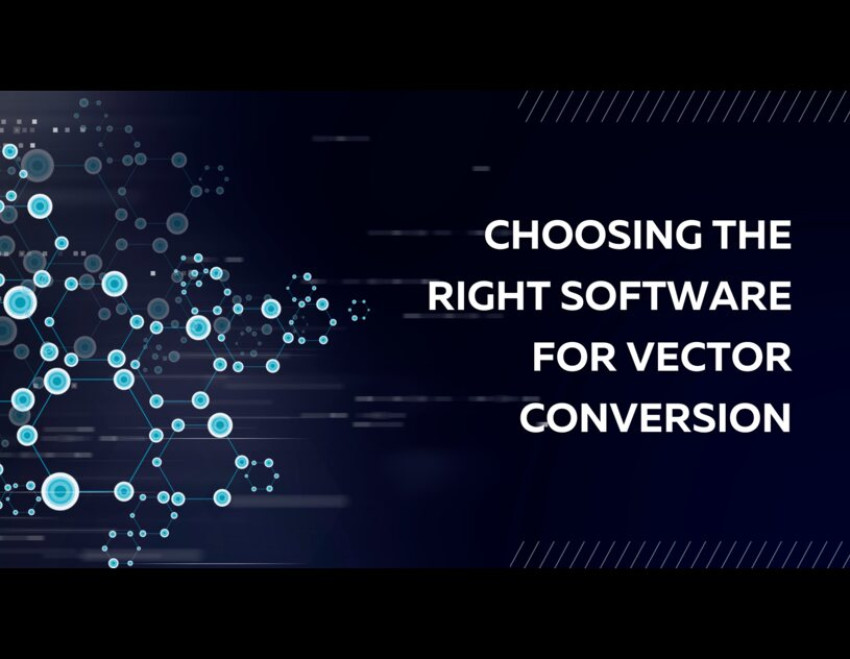
The ability to smoothly convert raster pictures into vectors has become essential in the fast-paced world of graphic design. Scalability without sacrificing quality is a feature that makes vector graphics indispensable for a variety of applications, ranging from large-scale printing to logo creation. The need for vectorization is increasing, and with it is the availability of tools for vector conversion. We will explore the world of vector conversion software in this extensive tutorial, assisting you in selecting the appropriate instruments for your artistic pursuits.
Comprehending Vector Conversion
Let's understand the fundamentals of vectorization before delving into the world of vector conversion tools. Vector graphics use mathematical equations to construct shapes, allowing for indefinite scalability, in contrast to raster images made up of pixels. The technique of converting raster images into scalable vector forms while maintaining the original design's clarity and integrity is known as vector conversion.
Crucial Elements to Consider for Accuracy: Select a tool that can accurately convert your raster image while preserving all of its fine characteristics.
Ease of Use: To make learning easier for both novice and experienced designers, choose software with an easy-to-use interface and functionality.
Output Formats: To ensure compatibility with various design software, take into consideration tools that support many vector file formats.
Batch Processing: To maximise efficiency, choose tools that provide batch processing, which makes it possible to convert several photographs at once.
Customisation Options: Seek a programme with capabilities that let you adjust the vectorization process to meet your unique requirements.
Top Vector Conversion Tools1. Adobe Illustrator: Known for its sophisticated vectorization features, Adobe Illustrator is a design software that is widely used in the business. Many designers choose it because of its many capabilities and smooth integration with other Adobe tools.
2. Adobe CorelDRAW
Well-known for its powerful vector editing features, CorelDRAW is an adaptable tool good for a range of creative jobs. It has excellent accuracy and provides sophisticated vectorization choices.
3. Using Inkscape
An easy-to-use free vector graphics editor is Inkscape, an open-source substitute. For those on a tight budget, it's a great option without sacrificing usefulness.
4. Magic Vector
Vector Magic, a vector conversion specialist, uses cutting-edge algorithms to provide outcomes that are of the highest calibre. To accommodate a range of user preferences, it provides both desktop and internet versions.
5. The Autotrace
AutoTrace is a command-line utility best suited for users who are accustomed to working with scripts. It is a dependable option for automated vectorization operations and offers effective batch processing.
Comparative Analysis and Suggestions
Let's evaluate these instruments according to certain important standards to help you make a decision:
Cost: Inkscape and AutoTrace are free, however Adobe Illustrator is a paid alternative. Both free and premium versions are available for CorelDRAW and Vector Magic.
Ease of Use: Inkscape is an excellent option for novices because of its notable simplicity. Given its wealth of capabilities, Adobe Illustrator might have a more challenging learning curve.
Customisation: When it comes to choices for fine-tuning vectorization parameters, CorelDRAW and Adobe Illustrator lead the pack. Automated procedures are Vector Magic's primary focus.
Compatibility: CorelDRAW and Adobe Illustrator are highly compatible with a wide range of file formats. While Inkscape is compatible with most formats, there may be extra procedures needed for Vector Magic and AutoTrace.
Some Advice for Effective Vectorization
High-quality images come first: To guarantee superior outcomes during the vectorization process, start with a high-resolution raster image.
Recognise Configuration: Become acquainted with the vector conversion tool's configuration. Adapt the parameters according to your design's features and complexity.
Before deciding, check it out: The majority of tools have a preview function. Before completing the vectorization process, use it to evaluate the results.
Update Software Frequently: To take advantage of the newest features and enhancements, make sure your vector conversion tools are up to date.
In summary
Selecting the appropriate vector conversion tool is essential to getting flawless outcomes for your creative tasks. When making a choice, take into account your project's particular requirements, expertise level, and budget. The most important thing is to choose a programme that fits your design objectives, whether that means going with open-source alternatives like Inkscape or industry heavyweights like Adobe Illustrator and CorelDRAW.
Choose the ideal vector conversion tool for your creative endeavours to unleash the possibilities of vector graphics. With the correct tools, you may enhance your designs, embrace scalability, and realise your ambitions.




